Effect of Xenon Ion Irradiation on the Properties of Austenitic Steel AISI 316
Abstract
1. Introduction
2. Materials and Methods
3. Results and Discussion
3.1. Irradiation of AISI 316 Samples
3.2. Surface Topography of AISI 316
3.3. GXRD Measurements
3.4. Coefficient of Friction and Wear of Steel
3.5. SEM Images of Countersamples
3.6. Microhardness
3.7. EDX Measurements
4. Conclusions
Author Contributions
Funding
Institutional Review Board Statement
Informed Consent Statement
Data Availability Statement
Acknowledgments
Conflicts of Interest
References
- Picard, S.; Memet, J.B.; Sabot, R.; Grosseau-Poussard, J.L.; Rivière, J.P.; Meilland, R. Corrosion Behaviour, Microhardness and Surface Characterisation of Low Energy, High Current Ion Implanted Austenitic Stainless Steel. Mater. Sci. Eng. A 2001, 303, 163–172. [Google Scholar] [CrossRef]
- Wang, F.; Zhou, C.; Zheng, L.; Zhang, H. Improvement of the Corrosion and Tribological Properties of CSS-42L Aerospace Bearing Steel Using Carbon Ion Implantation. Appl. Surf. Sci. 2017, 392, 305–311. [Google Scholar] [CrossRef]
- Budzyński, P.; Kamiński, M.; Pałka, K.; Droździel, A.; Wiertel, M. The Influence of Nitrogen Ion Implantation on Microhardness of the Stellite 6 Alloy. IOP Conf. Ser. Mater. Sci. Eng. 2016, 148, 012046. [Google Scholar] [CrossRef]
- Szala, M.; Chocyk, D.; Skic, A.; Kamiński, M.; Macek, W.; Turek, M. Effect of Nitrogen Ion Implantation on the Cavitation Erosion Resistance and Cobalt-Based Solid Solution Phase Transformations of HIPed Stellite 6. Materials 2021, 14, 2324. [Google Scholar] [CrossRef]
- Foerster, C.E.; da Silva, S.L.R.; Fitz, T.; Dekorsy, T.; Prokert, F.; Kreiβig, U.; Richter, E.; Möller, W.; Lepienski, C.M.; de M. Siqueira, C.J. Carbon Ion Implantation into Aluminium: Mechanical and Tribological Properties. Surf. Coat. Technol. 2006, 200, 5210–5219. [Google Scholar] [CrossRef]
- Saritas, S.; Procter, R.P.M.; Grant, W.A. The Use of Ion Implantation to Modify the Tribological Properties of Ti-6Al-4V Alloy. Mater. Sci. Eng. 1987, 90, 297–306. [Google Scholar] [CrossRef]
- Yan, S.; Zhao, W.J.; Rück, D.M.; Xue, J.M.; Wang, Y.G. Study of Tribological Properties of High-Speed Steel Implanted by High-Dose Carbon Ions. Surf. Coat. Technol. 1998, 103–104, 348–352. [Google Scholar] [CrossRef]
- Kaminski, M.; Budzynski, P.; Hunicz, J.; Jozwik, J. Evaluation of Changes in Fuel Delivery Rate by Electromagnetic injectors in a Common Rail System during Simulated Operation. Eksploat. I Niezawodn.-Maint. Reliab. 2021, 23, 352–358. [Google Scholar] [CrossRef]
- Dearnaley, G. Applications of Ion Implantation in Metals & Alloys. IEEE Trans. Nucl. Sci. 1981, 28, 1808–1811. [Google Scholar] [CrossRef]
- Kamiński, M.; Budzyński, P.; Surowiec, Z.; Wiertel, M.; Skuratov, V.A. Surface Morphology and Phase Stability of Titanium Irradiated with 168 MeV 136Xe Ions. Int. J. Mater. Res. 2018, 109, 779–784. [Google Scholar] [CrossRef]
- AL-Khoury, W.; Naddaf, M.; Ahmad, M. MeV-Fe Ions Implantation of GaAs—Induced Morphological and Structural Modification of Porous GaAs. Nucl. Instrum. Methods Phys. Res. B 2021, 492, 1–6. [Google Scholar] [CrossRef]
- Bosia, F.; Argiolas, N.; Bazzan, M.; Olivero, P.; Picollo, F.; Sordini, A.; Vannoni, M.; Vittone, E. Modification of the Structure of Diamond with MeV Ion Implantation. Diam. Relat. Mater. 2011, 20, 774–778. [Google Scholar] [CrossRef]
- Jin, H.H.; Hwang, S.S.; Choi, M.J.; Lee, G.G.; Kwon, J. Proton Irradiation for Radiation-Induced Changes in Microstructures and Mechanical Properties of Austenitic Stainless Steel. J. Nucl. Mater. 2019, 513, 271–281. [Google Scholar] [CrossRef]
- Jin, H.H.; Ko, E.; Lim, S.; Kwon, J.; Shin, C. Effect of Irradiation Temperature on Microstructural Changes in Self-Ion Irradiated Austenitic Stainless Steel. J. Nucl. Mater. 2017, 493, 239–245. [Google Scholar] [CrossRef]
- Radiguet, B.; Etienne, A.; Pareige, P.; Sauvage, X.; Valiev, R. Irradiation Behavior of Nanostructured 316 Austenitic Stainless Steel. J. Mater. Sci. 2008, 43, 7338–7343. [Google Scholar] [CrossRef]
- Hure, J.; Courcelle, A.; Turque, I. A Micromechanical Analysis of Swelling-Induced Embrittlement in Neutron-Irradiated Austenitic Stainless Steels. J. Nucl. Mater. 2022, 565, 153732. [Google Scholar] [CrossRef]
- Huang, H.F.; Li, J.J.; Li, D.H.; Liu, R.D.; Lei, G.H.; Huang, Q.; Yan, L. TEM, XRD and Nanoindentation Characterization of Xenon Ion Irradiation Damage in Austenitic Stainless Steels. J. Nucl. Mater. 2014, 454, 168–172. [Google Scholar] [CrossRef]
- Lim, Y.S.; Kim, D.J.; Choi, M.J.; Hwang, S.S.; Kim, S.W. Effects of the Dose and Depth on the Microstructural Characteristics of Proton-Irradiated Austenitic 316 Stainless Steel. Mater. Charact. 2022, 194, 112445. [Google Scholar] [CrossRef]
- Prasad, S.V.; Michael, J.R.; Battaile, C.C.; Majumdar, B.S.; Kotula, P.G. Tribology of Single Crystal Nickel: Interplay of Crystallography, Microstructural Evolution, and Friction. Wear 2020, 458–459, 203320. [Google Scholar] [CrossRef]
- Kamiński, M.; Budzyński, P.; Surowiec, Z.; Wiertel, M.; Zdorovets, M.V.; Kozlovskiy, A.; Waliszewski, J.; Magdziak, M. Effect of 160 MeV Xenon Ion Irradiation on the Tribological Properties and Crystal Structure of 100Cr6 Bearing Steel. Materials 2023, 16, 6660. [Google Scholar] [CrossRef]
- Budzyński, P.; Kamiński, M.; Surowiec, Z.; Wiertel, M.; Skuratov, V.A.; Korneeva, E.A. Effects of Xenon-Ion Irradiation on the Tribological Properties and Crystal Structure of Titanium and Its Alloy Ti6Al4V. Tribol. Int. 2021, 156, 106854. [Google Scholar] [CrossRef]
- Sader, J.E.; Chon, J.W.M.; Mulvaney, P. Calibration of Rectangular Atomic Force Microscope Cantilevers. Rev. Sci. Instrum. 1999, 70, 3967–3969. [Google Scholar] [CrossRef]
- Horcas, I.; Fernández, R.; Gómez-Rodríguez, J.M.; Colchero, J.; Gómez-Herrero, J.; Baro, A.M. WSXM: A Software for Scanning Probe Microscopy and a Tool for Nanotechnology. Rev. Sci. Instrum. 2007, 78, 013705. [Google Scholar] [CrossRef] [PubMed]
- ASTM G99-17; Standard Test Method for Wear Testing with a Pin-on-Disk Apparatus. ASTM International: West Conshohocken, PA, USA, 2017.
- ASTM E384-22; Standard Test Method for Microindentation Hardness of Materials. ASTM International: West Conshohocken, PA, USA, 2021.
- Ziegler, J.F.; Ziegler, M.D.; Biersack, J.P. SRIM—The Stopping and Range of Ions in Matter (2010). Nucl. Instrum. Methods Phys. Res. B 2010, 268, 1818–1823. [Google Scholar] [CrossRef]
- Oyarzabal, Í.M.; Tunes, M.A.; Camara, O.; Aradi, E.; Mir, A.H.; Greaves, G.; Hinks, J.A.; Fitchner, P.F.P.; Donnelly, S.E. The Effect of Flux on Ion Irradiation-Enhanced Precipitation in AISI-316L: An in-Situ TEM Study. J. Nucl. Mater. 2020, 541, 152414. [Google Scholar] [CrossRef]
- Was, G.S. Fundamentals of Radiation Materials Science: Metals and Alloys; Springer: New York, NY, USA, 2007; ISBN 978-3540494713. [Google Scholar]
- Behrisch, R.; Eckstein, W. Sputtering by Particle Bombardment: Experiments and Computer Calculations from Threshold to MeV Energies; Springer: Berlin/Heidelberg, Germany, 2007; ISBN 978-3-540-44500-2. [Google Scholar]
- Matsunami, N.; Yamamura, Y.; Itikawa, Y.; Itoh, N.; Kazumata, Y.; Miyagawa, S.; Morita, K.; Shimizu, R.; Tawara, H. Energy Dependence of the Ion-Induced Sputtering Yields of Monatomic Solids. At. Data Nucl. Data Tables 1984, 31, 1–80. [Google Scholar] [CrossRef]
- Lin, J.; Chen, F.; Tang, X.; Liu, J.; Shen, S.; Ge, G. Radiation-Induced Swelling and Hardening of 316L Stainless Steel Fabricated by Selected Laser Melting. Vacuum 2020, 174, 109183. [Google Scholar] [CrossRef]
- Jagielski, J.; Thomé, L. Multi-Step Mechanism of Damage Accumulation in Irradiated Crystals. Nucl. Instrum. Methods Phys. Res. B 2008, 266, 1212–1215. [Google Scholar] [CrossRef]
- Debelle, A.; Moll, S.; Décamps, B.; Declémy, A.; Thomé, L.; Sattonnay, G.; Garrido, F.; Jozwik, I.; Jagielski, J. Ability of Cubic Zirconia to Accommodate Radiation Damage. Scr. Mater. 2010, 63, 665–668. [Google Scholar] [CrossRef]
- Mieszczynski, C.; Ratajczak, R.; Jagielski, J.; Velişa, G.; Bei, H.; Sales, B.C.; Wendler, E.; Weber, W.J.; Zhang, Y. Defect Evolution in Ni and Solid-Solution Alloys of NiFe and NiFeCoCr under Ion Irradiation at 16 and 300 K. J. Nucl. Mater. 2020, 534, 152138. [Google Scholar] [CrossRef]
- Weber, W.J.; Duffy, D.M.; Thomé, L.; Zhang, Y. The Role of Electronic Energy Loss in Ion Beam Modification of Materials. Curr. Opin. Solid State Mater. Sci. 2015, 19, 1–11. [Google Scholar] [CrossRef]
- Song, R.B.; Xiang, J.Y.; Hou, D.P. Characteristics of Mechanical Properties and Microstructure for 316L Austenitic Stainless Steel. J. Iron Steel Res. Int. 2011, 18, 53–59. [Google Scholar] [CrossRef]
- Gundgire, T.; Jokiaho, T.; Santa-aho, S.; Rautio, T.; Järvenpää, A.; Vippola, M. Comparative Study of Additively Manufactured and Reference 316 L Stainless Steel Samples—Effect of Severe Shot Peening on Microstructure and Residual Stresses. Mater. Charact. 2022, 191, 112162. [Google Scholar] [CrossRef]
- Budzyński, P. Effect of Ion Irradiation on the Properties of Metals and Alloys, 1st ed.; Routledge: London, UK, 2024. [Google Scholar]
- Zhang, X.; Zhang, Z.; Akhmadaliev, S.; Zhou, S.; Wu, Y.; Guo, B. Structural and Magnetic Properties of Swift Heavy-Ion Irradiated SiC. Vacuum 2021, 184, 109849. [Google Scholar] [CrossRef]
- Dey, S.; Dutta, A.; Mukherjee, P.; Gayathri, N.; Gupta, A.D.; Roy, T.K. Characterization of Ion Induced Damage as a Function of Depth in Proton Irradiated Pure Ti and Ti–6Al–4V. J. Alloys Compd. 2020, 821, 153441. [Google Scholar] [CrossRef]
- Dai, L.Y.; Niu, G.Y.; Ma, M.Z. Microstructure Evolution and Nanotribological Properties of Different Heat-Treated AISI 420 Stainless Steels after Proton Irradiation. Materials 2019, 12, 1736. [Google Scholar] [CrossRef]
- Okubo, N.; Fujimura, Y.; Tomobe, M. Effect of Irradiation on Corrosion Behavior of 316L Steel in Lead-Bismuth Eutectic with Different Oxygen Concentrations. Quantum Beam Sci. 2021, 5, 27. [Google Scholar] [CrossRef]
- Sizmann, R. The Effect of Radiation upon Diffusion in Metals. J. Nucl. Mater. 1978, 69–70, 386–412. [Google Scholar] [CrossRef]
- Ye, Z.; Lei, Y.; Zhang, J.; Zhang, Y.; Li, X.; Xu, Y.; Wu, X.; Liu, C.S.; Hao, T.; Wang, Z. Effects of Oxygen Concentration and Irradiation Defects on the Oxidation Corrosion of Body-Centered-Cubic Iron Surfaces: A First-Principles Study. Chin. Phys. B 2022, 31, 86802. [Google Scholar] [CrossRef]
- Alonso, F.; García, A.; Ugarte, J.J.; Viviente, J.L.; Oñate, J.I.; Baranda, P.S.; Cooper, C.V. Changes in Tribological Properties of an AISI 440C Martensitic Stainless Steel after Ion Implantation of Carbon at Very High Doses. Surf. Coat. Technol. 1996, 83, 263–268. [Google Scholar] [CrossRef]
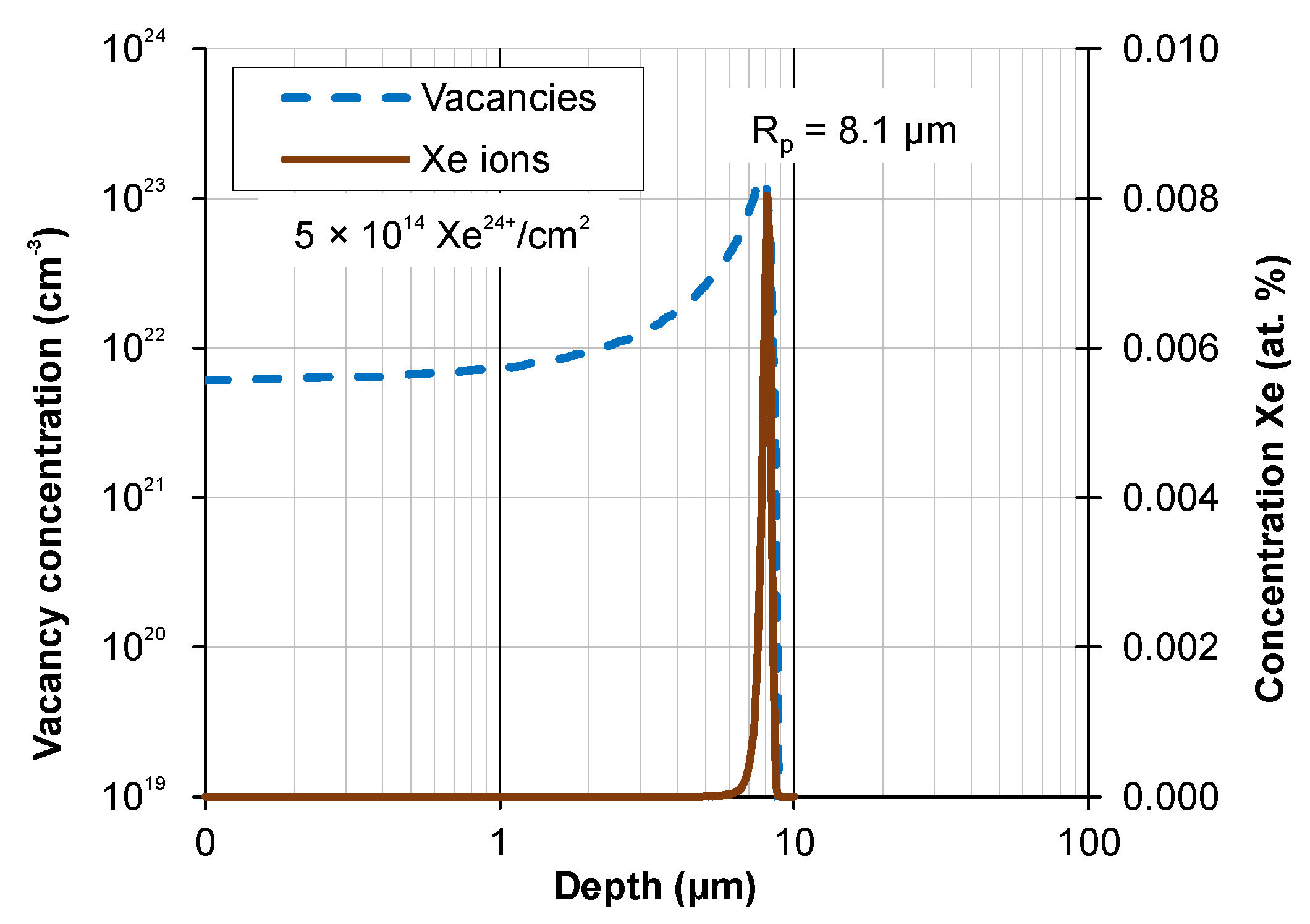
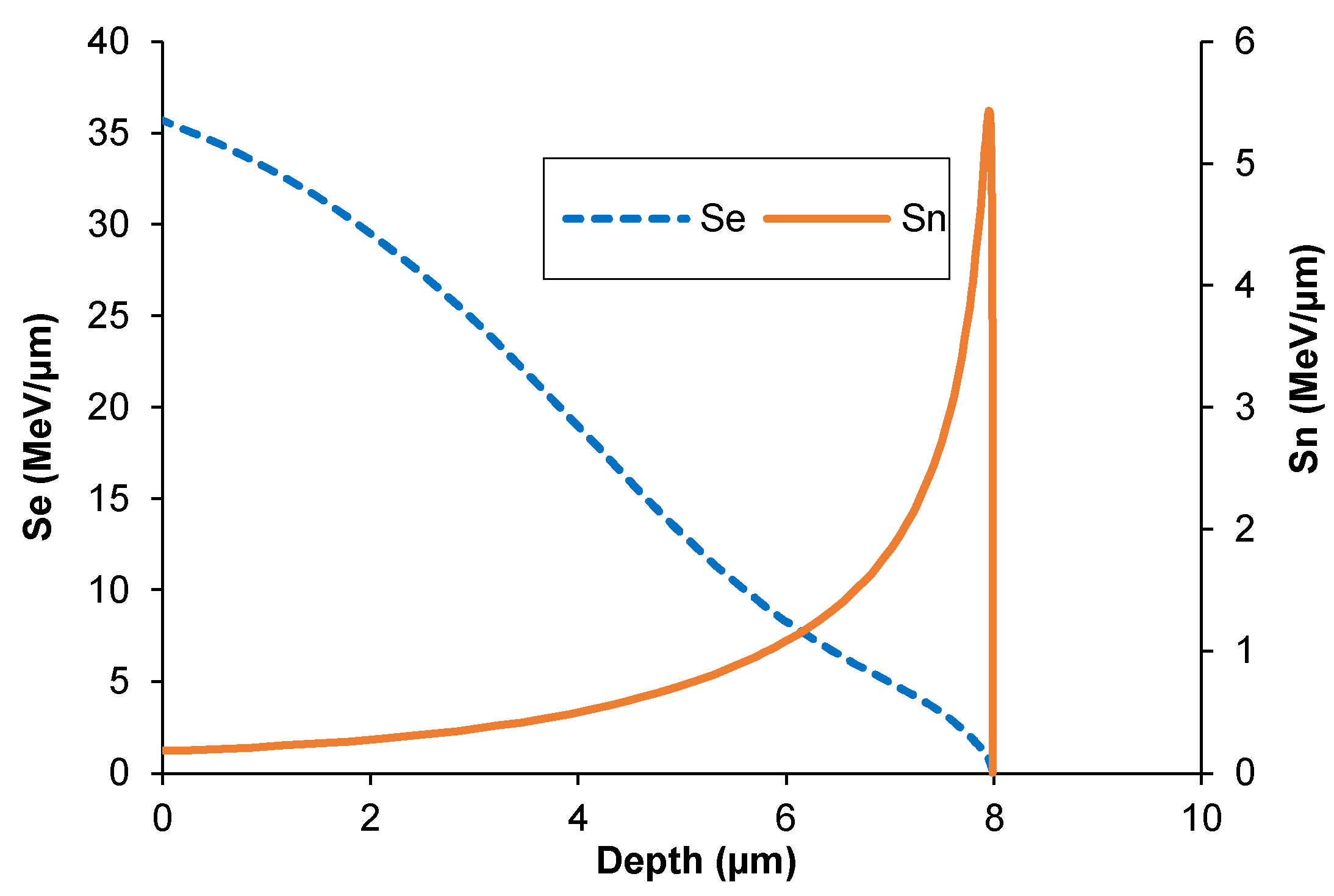
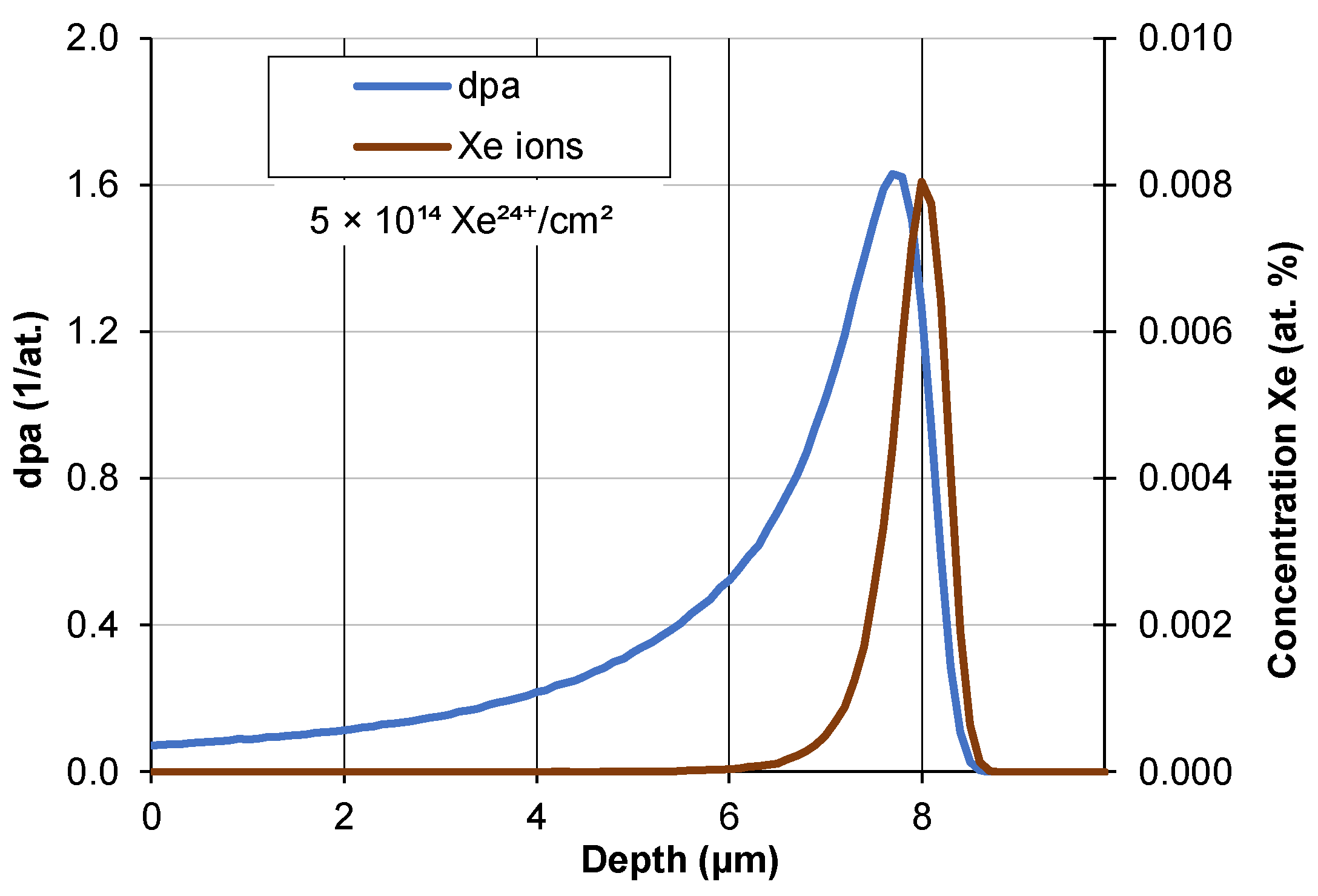


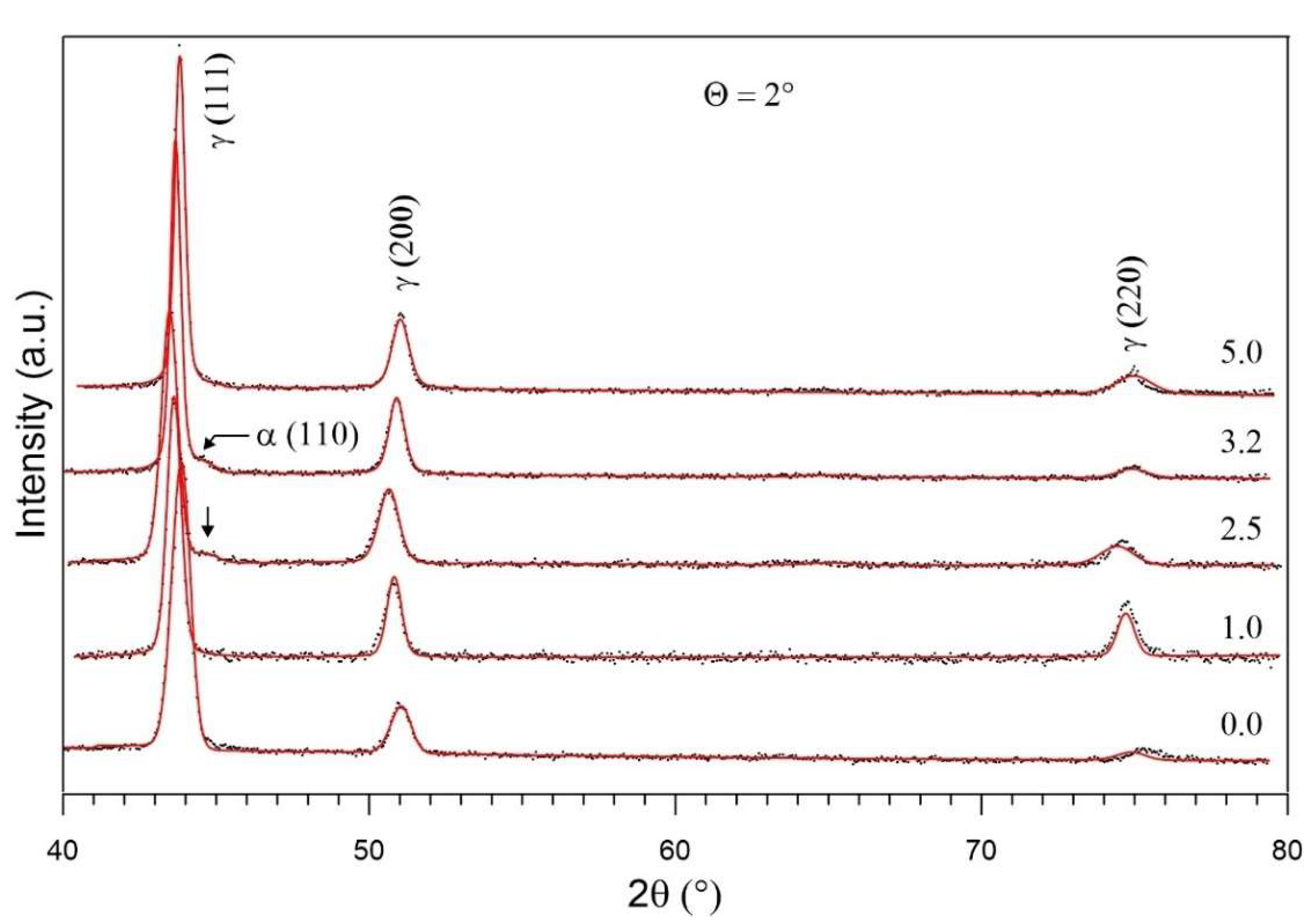
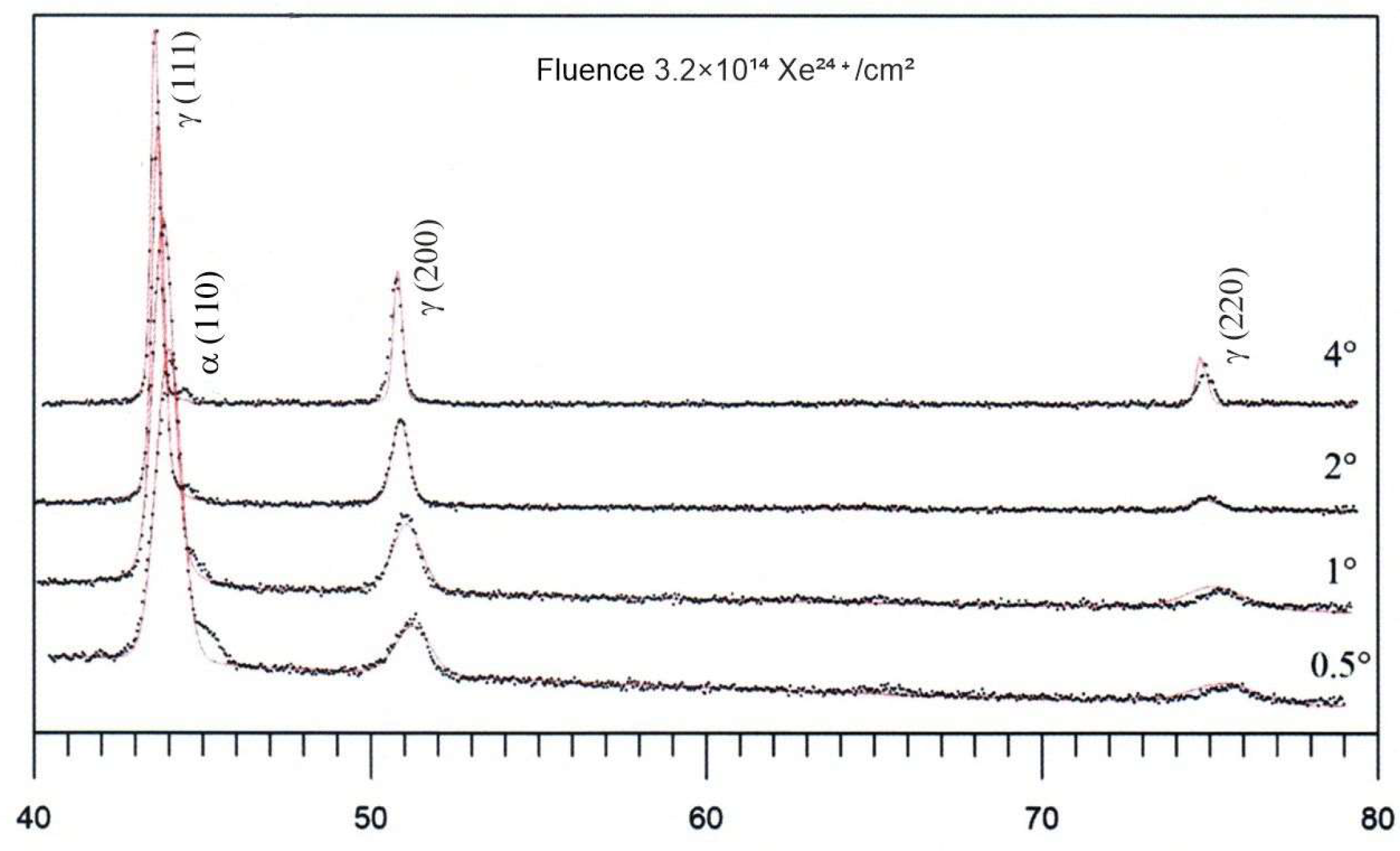
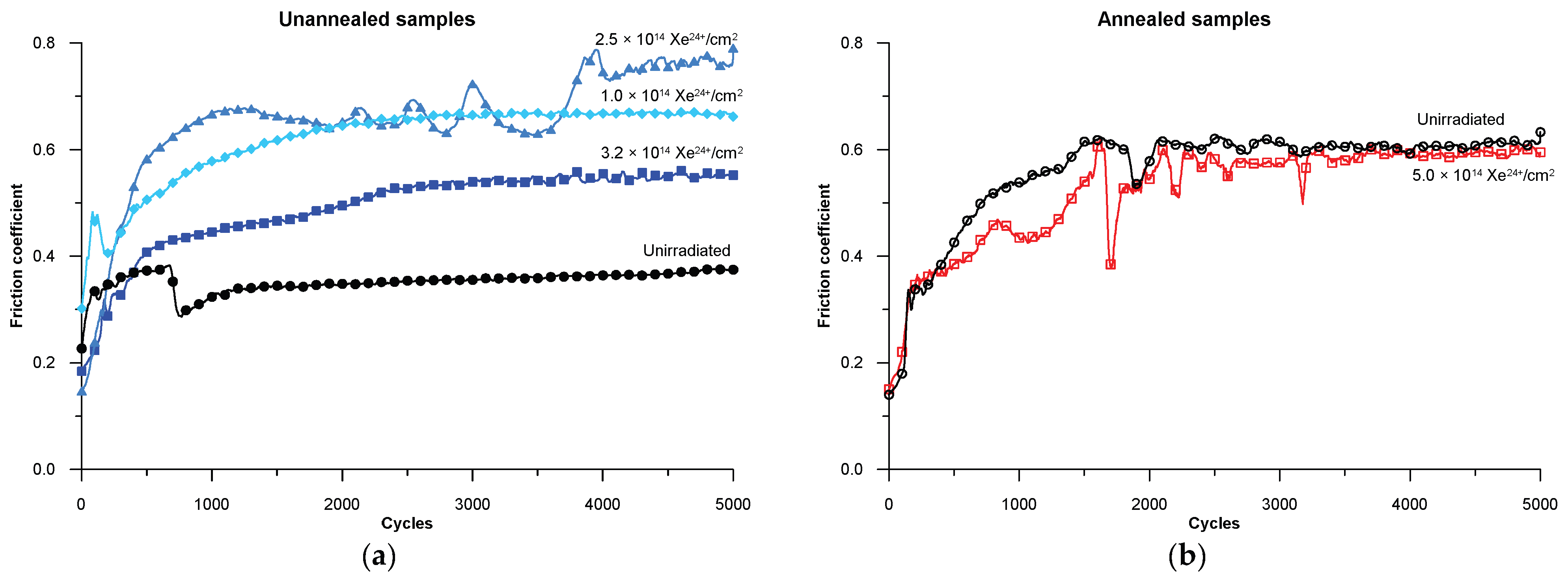
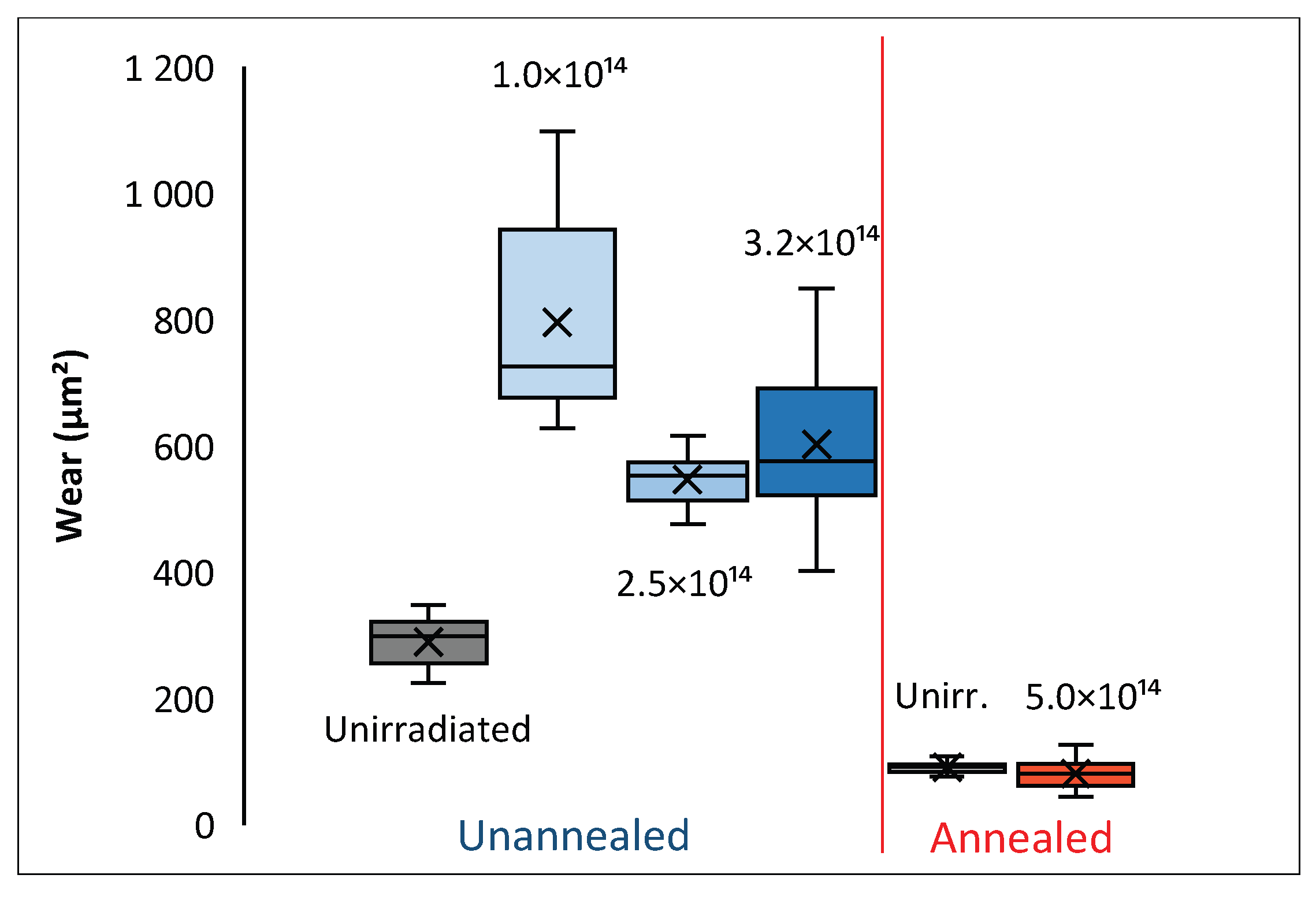
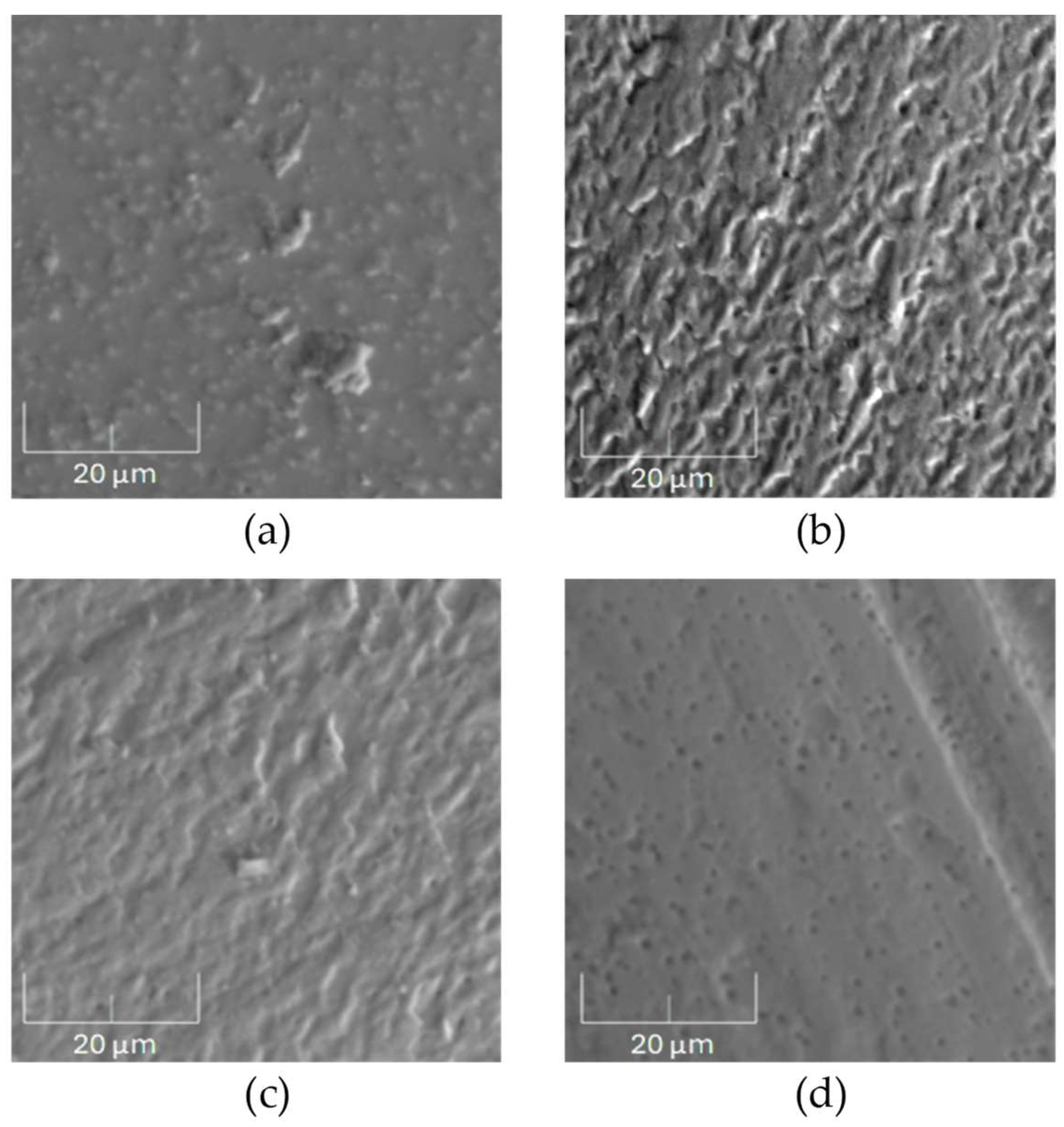
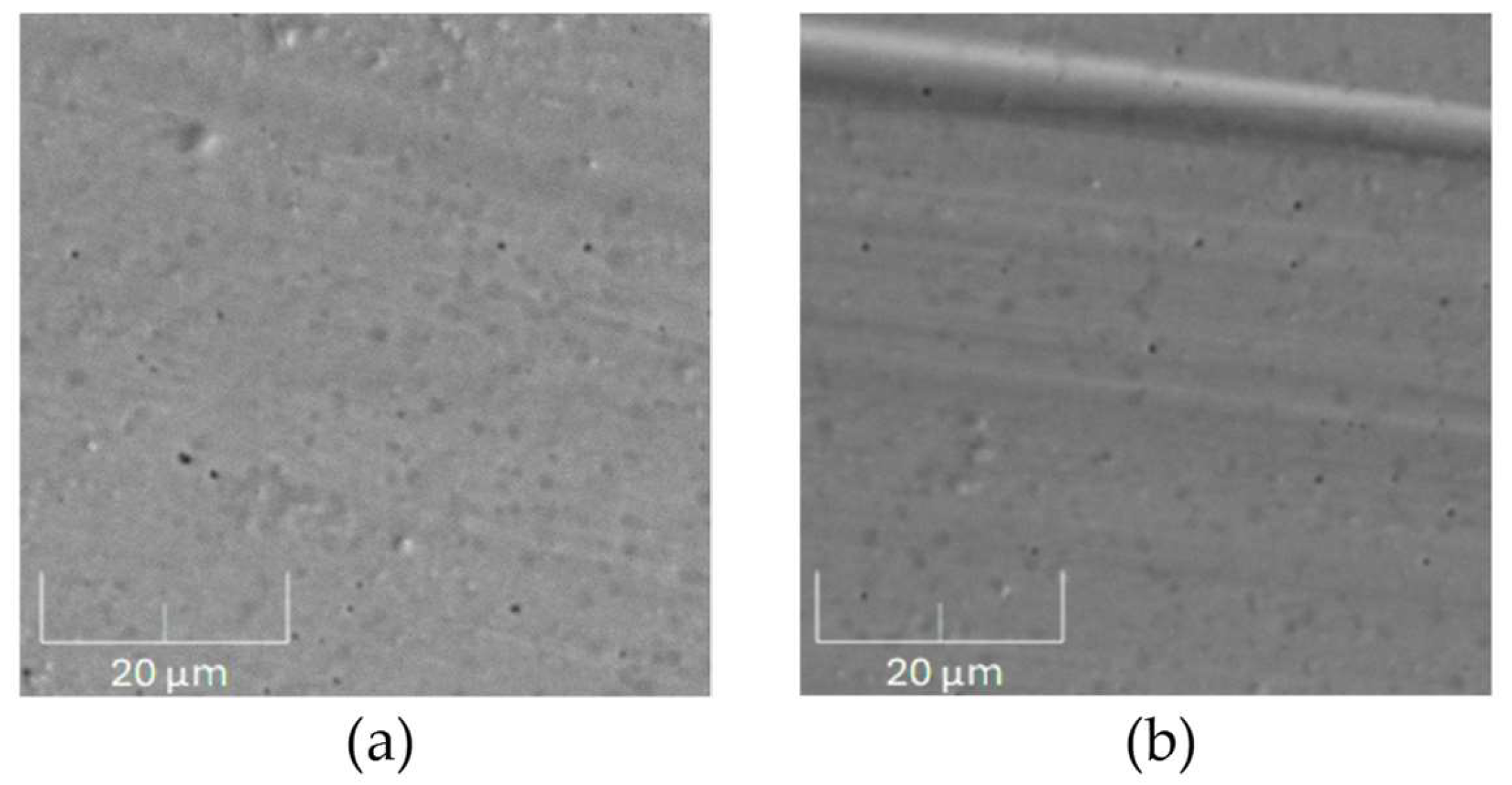

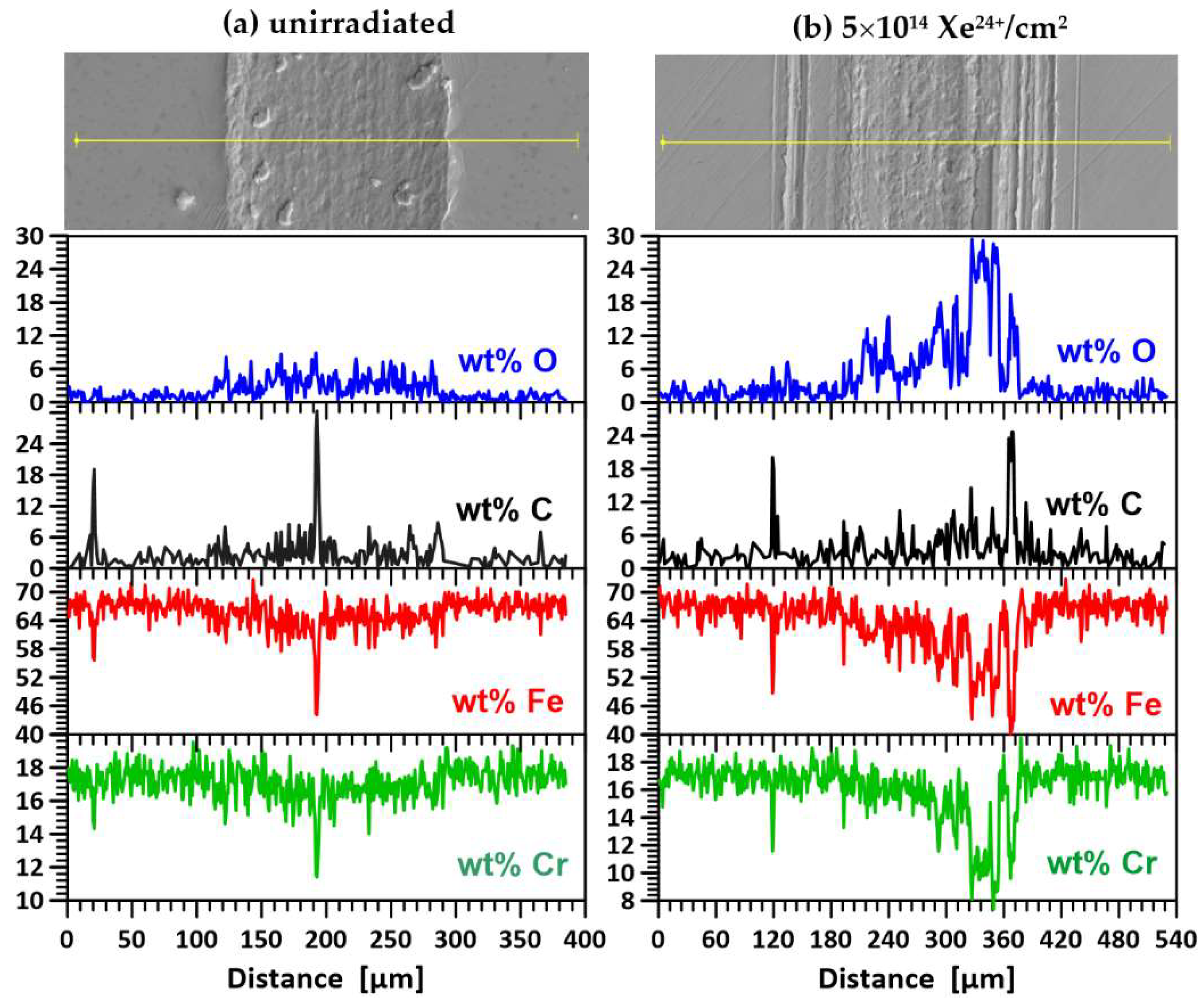
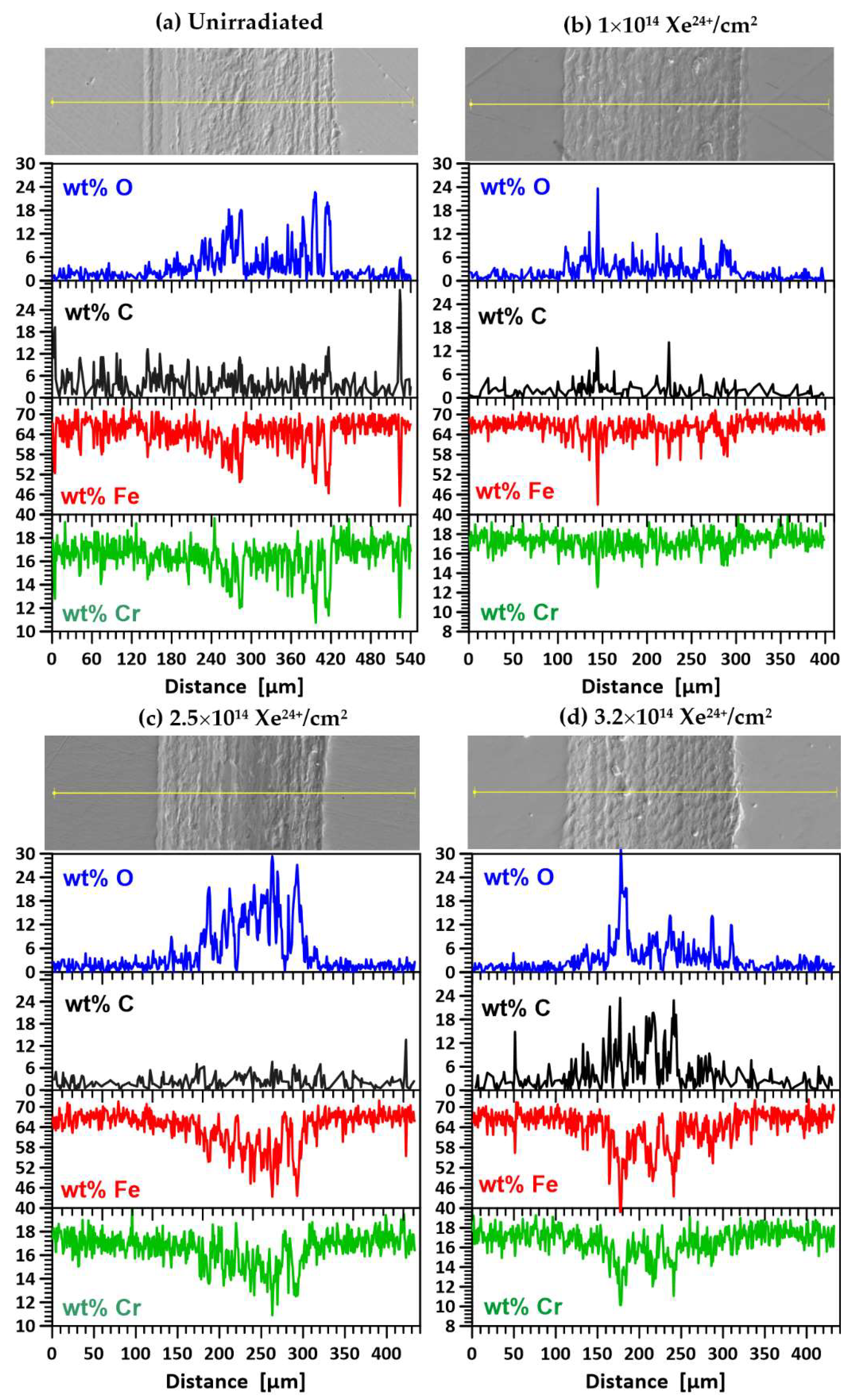
| Element (wt. %)/Steel | C | Cr | Mn | Mo | Si | Ni | Cu | P | S | N | Fe |
|---|---|---|---|---|---|---|---|---|---|---|---|
| AISI 316 | <0.07 | 17.5 | 1.9 | 2.0 | <1 | 12.5 | - | <0.04 | <0.02 | <0.01 | balance |
| 100Cr6 | 1.1 | 1.5 | 0.30 | ≤0.10 | 0.25 | ≤0.40 | ≤0.30 | <0.03 | <0.03 | - | balance |
| Fluence (Xe24+/cm2)/Δa (nm) | Θ = 0.5°d = 0.097 µm | Θ = 1°d = 0.194 µm | Θ = 2°d = 0.388 µm | Θ = 4°d = 0.776 µm |
|---|---|---|---|---|
| 1.0 × 1014 | 0.0014 (2) | 0.0013 (2) | 0.0020 (2) | 0.0011 (2) |
| 2.5 × 1014 | 0.0012 (2) | 0.0016 (2) | 0.0025 (2) | 0.0016 (2) |
| 3.2 × 1014 | 0.0004 (2) | 0.0011 (2) | 0.0008 (2) | 0.0001 (2) |
| 5.0 × 1014 | 0.0004 (2) | 0.0015 (2) | 0.0003 (2) | 0.0002 (2) |
| Sample | HV 0.025 | HV 0.2 | HV 0.3 |
|---|---|---|---|
| Unannealed, unirradiated | 240 ± 4 | 193 ± 4 | 189 ± 3 |
| Unannealed, 1.0 × 1014 Xe24+/cm2 | 257 ± 7 | 215 ± 5 | 202 ± 3 |
| Unannealed, 2.5 × 1014 Xe24+/cm2 | 257 ± 8 | 211 ± 5 | 202 ± 5 |
| Unannealed, 3.2 × 1014 Xe24+/cm2 | 279 ± 10 | 213 ± 3 | 206 ± 3 |
| Annealed, unirradiated | 249 ± 5 | 182 ± 2 | 175 ± 2 |
| Annealed, 5.0 × 1014 Xe24+/cm2 | 306 ± 7 | 202 ± 2 | 193 ± 2 |
Disclaimer/Publisher’s Note: The statements, opinions and data contained in all publications are solely those of the individual author(s) and contributor(s) and not of MDPI and/or the editor(s). MDPI and/or the editor(s) disclaim responsibility for any injury to people or property resulting from any ideas, methods, instructions or products referred to in the content. |
© 2024 by the authors. Licensee MDPI, Basel, Switzerland. This article is an open access article distributed under the terms and conditions of the Creative Commons Attribution (CC BY) license (https://creativecommons.org/licenses/by/4.0/).
Share and Cite
Budzyński, P.; Kamiński, M.; Surowiec, Z.; Wiertel, M. Effect of Xenon Ion Irradiation on the Properties of Austenitic Steel AISI 316. Materials 2024, 17, 5094. https://doi.org/10.3390/ma17205094
Budzyński P, Kamiński M, Surowiec Z, Wiertel M. Effect of Xenon Ion Irradiation on the Properties of Austenitic Steel AISI 316. Materials. 2024; 17(20):5094. https://doi.org/10.3390/ma17205094
Chicago/Turabian StyleBudzyński, Piotr, Mariusz Kamiński, Zbigniew Surowiec, and Marek Wiertel. 2024. "Effect of Xenon Ion Irradiation on the Properties of Austenitic Steel AISI 316" Materials 17, no. 20: 5094. https://doi.org/10.3390/ma17205094
APA StyleBudzyński, P., Kamiński, M., Surowiec, Z., & Wiertel, M. (2024). Effect of Xenon Ion Irradiation on the Properties of Austenitic Steel AISI 316. Materials, 17(20), 5094. https://doi.org/10.3390/ma17205094







